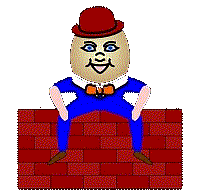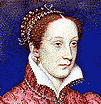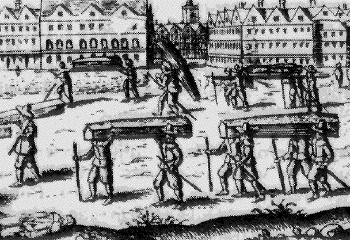Some British Nursery Rhymes
and their origins
Humpty Dumpty sat on a wall.
Humpty Dumpty had a great fall.
And all the king's horses,
And all the king's men,
Couldn't put Humpty together again.
King Richard III was, according to his critics, a short, deformed man. He was reputed to be hunchback. In fact, this wasn't true - he was a strong, tall man who was fond of sport and jousting.
|
 |
 |
In 1485, Richard lost the Battle of Bosworth Field against Henry Tudor (who became Henry VII) and was treacherously killed in the battle. This explains the reference to all the King's horses and all the king's men in the rhyme.
In the Tudor era that followed, Richard III became known as "hump-backed Dick" and was ridiculed as a monster. Gradually over the years, "hump-backed Dick" became "Humpty Dumpty".
|
Mary, Mary, quite contrary
How does your garden grow?
With silver bells, and cockle shells,
And little maids all in a row.
|
 |
Now we move a hundred years further on, to the time of Queen Elizabeth I. When her cousin, Mary, Queen of the Scots, (shown above) crossed the border into England, fleeing from her enemies, Elizabeth was worried that she might try to seize the throne of England, so she had her imprisoned in a castle (well, a series of castles) in the Midlands. Mary spent the last 19 years of her life in prison.
Mary was a Catholic queen, and Elizabeth, who was a Protestant, was continually worried that rebellious Catholics in England would rally round her. There were several plans to spring Mary from prison, the most famous of which was the Babbington Plot. Anthony Babbington, and a few Catholic friends, sent coded messages to Mary and she sent them coded messages back supporting their plot.
Fortunately for Elizabeth, the head of her secret service, Francis Walsingham, had the messages decoded and the plot was revealed. Babbington and the plotters were tortured and executed. Mary was put on trial, and eventually beheaded. Shortly afterwards the rhyme was coined to commemorate the Babbington Plot.
 |
London Bridge is falling down,
Falling down, falling down.
London Bridge is falling down,
My fair lady!
|
This rhyme commemorates the time in the ninth century when Viking raiders sailed their long-boat up the Thames to attack the city of London. Their ship was too large to pass underneath the wooden bridge, so they tied ropes to the bow of their ship and to the pillars of the bridge. Then they rowed hard the other way, eventually pulling the wooden structure down!
There are other verses to the song, saying how we are going to build the bridge up again, but I have missed them out as they make it rather long.
Ring-a-ring of roses,
A pocket full of posies,
A-tishoo, a-tishoo!
We all fall down.
|
 |
In the 1660s, bubonic plague struck England and was especially prevalent in London. It was caused when infected fleas, who had been sucking the blood of rats, jumped onto human beings. The symptoms of this disease were horrific: the buboes (glands in the neck and groin) swelled up and the victims started to vomit and to suffer from diarrhoea. They usually died within a few days.
The "ring of roses" could be something to do with the marks that appeared on victims' necks shortly before the buboes swelled up. The pocket full of posies referred to the bunches of sweet-smelling flowers that people kept close to their noses to avoid the smell of the rotting corpses that pervaded everywhere. I suppose "A-tishoo a-tishoo" refers to the symptoms of the disease - but "We all fall down" is fairly clear - fall down dead!
Incidentally, the plague is responsible for the fact that British people say "Bless you!" when someone sneezes. Doctors in the seventeenth century were almost complete useless. Knowing this, people tended to call in priests rather than doctors when they knew they were dying, so that the priests could bless them.
 |
Rock-a-bye baby, on the tree top.
When the wind blows, the cradle will rock.
When the bough breaks, the cradle will fall.
Down will come baby, cradle and all!
|
Not much is known about the origins of "Rock-a-bye baby". It is believed that it refers to the Tudor period. The "cradle" is the Tudor throne, which was put in danger by many rebellions and armed uprisings in the sixteenth century. The "baby" referred to may well be the young King Edward VI, who was Henry VIII's only son. He wasn't even ten years old when he came to the throne, and his rule was always a precarious one.
 Go back
Go back






 Go back
Go back